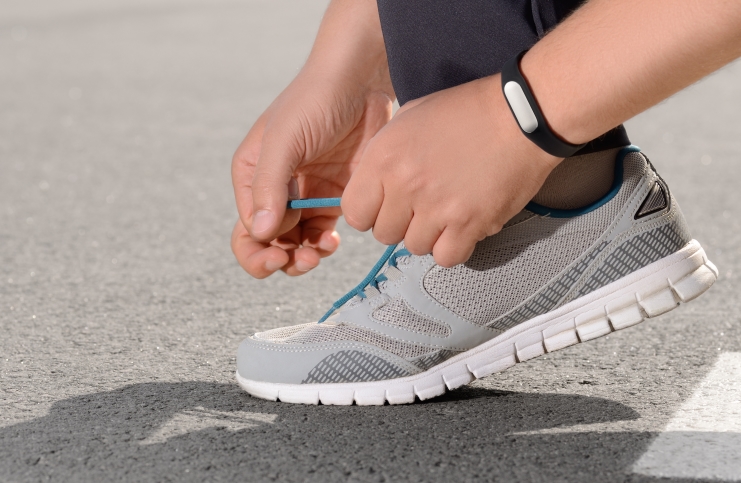On average, people who use a pedometer as part of their daily fitness routine add a minimum of 2,000 steps per day to their total output (source).
Research shows that the majority of people often overestimate their actual daily exercise by as much as 51 percent. Even those who meet the clinical criteria for being considered “very active” are guilty. For this reason alone, it’s no surprise America and many other nations are in the midst of a serious obesity and diabetes epidemic.
In order to consider yourself as being an “active” person, you need to be putting in at least 10,000 steps every day (source). If time is at a premium, or you simply don’t like to exercise for very long, a pedometer is a tool that can help you make sure you’re getting just enough exercise to stay healthy and disease free.
Advantages of Using a Pedometer
Setting Current Activity Baseline
Few people realize just how little exercise they get each day. Walking up the stairs at work and making a midday or evening jaunt to the convenience store down the street really don’t count as exercise either.
A pedometer helps you to see where you’re at and plan for improvements to your current activity level.
Setting Goals & Progress Tracking
When you realize just how little exercise you’re getting compared to what’s considered “active” a pedometer will help you to set reasonable goals for improvement, then keep you on top of those goals by reminding you (literally) every step of the way!
It’s hard to justify cutting your walk short when the numbers are right there on your pedometer, urging you to go on.
Calorie Management
Nearly all modern pedometers, even the cheaper varieties, are quite accurate at tracking calories burned during a workout. All that’s required from the user is to follow the setup instructions and input their weight and estimated stride length into the device prior to using it.
Depending on which model you choose, most pedometers will store your steps walked, total distance, calories burned, etc., for anywhere from 7 – 31 days. This makes it easy to make sure you’re burning your target number of calories every workout – and over the course of a week or more.
Stopwatch
Once you set a baseline time and pace where you know you’re reaching your goals (number of steps, total distance and/or calories burned) the stopwatch feature on most entry level models or better, can help you keep on schedule without missing time with family or keep you on schedule if you’re exercising during a break from work.
Even if your main goal is to get the recommended 30-minutes of brisk exercise per day, a stopwatch can certainly help to keep you on track. Most all pedometers with a stopwatch will have an alarm function that beeps when your goal is met too.
Never Walk Alone (Cloud Connectivity)
All smart pedometers have Internet connectivity which allows users to connect to other users using the same app or online group to walk together. There are too many apps and online groups to mention. Some are available for free, some paid, others come free when you buy a certain pedometer.
Being able to walk with other pedometer and app users can make getting 10,000 steps or more every day much more enjoyable than going it alone. Not to mention being able to challenge and otherwise motivate yourself and others.
Motivation
With all the numerous features available, including cloud connectivity, it’s never been easier to stay motivated while walking or running. The fact that you can track so much data makes it easy to stay motivated from one day to the next.
A quality pedometer is like a silent coach that’s there with you every step of the way, tracking your progress and urging you to keep going.
Digital vs Mechanical vs Smart Pedometers and Apps
There are 3 official types of gadgets one can use to track the distance they’ve walked or ran:
1. Mechanical Pedometer:
This type of pedometer was the very first to ever be introduced. A small pendulum inside the device swings back and forth according to the impact of the user’s feet on the ground. As the pendulum swings back and forth, a dial on top of the pedometer is turned to show how many steps have been taken. With the advent of digital pedometers, this type soon fell out of favor as they can be quite inaccurate and are easy to damage when dropped.
2. Digital Pedometer:
A digital pedometer has a small metal pendulum inside of it that swings according to the impact of the user as they step on the ground. As the metal contact end of the pendulum swings back and forth, it completes an electrical circuit telling the display that a step has occurred. This type of pedometer was most popular prior to accelerometers being introduced in smart phones. They’re far superior to mechanical pedometers.
3. Smart Pedometers:
Smart pedometers are essentially a smartphone without the phone functionality. However, pedometer apps are also available for smartphone users. An accelerometer inside tells the device every time a step occurs. There are also smart apps that work based of GPS location rather than steps taken – logging the distance in the app from the time you start walking until the time you stop.
Most Popular Pedometer Designs
Open Face Pedometers
Open face pedometers are normally the least expensive to buy. The readout is located on the front, along with the function buttons. Some will come with a clip to clip the unit to your waistband, others are designed to place in your pocket.
The biggest issue with this type of pedometer isn’t necessarily accuracy issues (even though you’ll find plenty that have this problem), but more that the open face design makes it easy to hit the reset button accidentally, unless the button is recessed or requires you to hold it down for 5 seconds or more to activate.
Flip Case Pedometers
Flip case pedometers are exactly the same as an open face, with the exception that there’s a front flip down cover that closes to protect the display and the function buttons, including the reset button. They can be more expensive, but the price difference is usually negligible.
Flip case pedometers are also offered with either a waistband belt clip or meant to be carried in your pocket.
Top Read Pedometers
Top read pedometers only come in a waistband clip design. This design also counts steps based on the back and forth motion of an internally mounted pendulum. The display faces upward so all the user has to do is look down to see their data. There’s no protective cover for the display, but the buttons on a top read are usually well protected from accidentally bumping them because of the design.
Some people find this design uncomfortable because they’re top heavy. This issue can be a particular nuisance if running with the device.
*Note: Many open face, flip case, and top read pedometers suffer from accuracy issues unless they’re oriented the exact way the manufacturer recommends. To avoid this issue, look for pedometers promising accuracy from either vertical or horizontal alignment.
Wrist Pedometers
Wrist pedometers come in a number of different designs:
• Motion-Sensing Chip: Rather than a traditional pendulum, this type of wrist pedometer has a chip that’s designed to pick up motion. Technology is getting better, but this type of watch only favors people who swing their arms in cadence with each step they take.
• Separate Mounted Sensor: With this design, an external sensor/sending unit transfers data wirelessly to the watch. These sensors are most often a clip-on, ankle bracelet, or mounted on the user’s shoes (either by a clip on or permanently embedded in the shoe from the factory).
• GPS: Most GPS wrist pedometers will not give a step count, nor will those that claim to be 100% accurate. This style tells you the distance you’ve moved and the speed traveled.
For those looking for a step counter, the motion-sensing chip design is the only reliable wrist wearable design for doing so; again, provided you always swing your arms while walking or running.
Smart Pedometers
Smart pedometers are the latest craze. They can count steps based on an internally mounted accelerometer as described earlier. Smart pedometers come with a touchscreen, complete with all the bells and whistles. Some can also double as a portable music player.
While there’s no difference between this kind of dedicated device and a smartphone with a pedometer app installed, some people prefer to have a separate device to track their walking goals.
What to Look for Before Settling on a Pedometer
Ease of Use
Is the pedometer easy to use? Some are very clunky when in use, with overly specific instructions as to how the device needs to be worn for maximum accuracy. Other units are made by foreign manufacturers who don’t put any thought into how easy the menu and various options are to access, scroll through, and adjust. Read product reviews to determine whether the pedometer you’re considering will be mostly frustration-free.
Accuracy
While most have the same basic design principles, that doesn’t mean that all pedometers will give you the same readout. Much of a pedometer’s accuracy comes from following the instructions provided by the manufacturer for programming your unique stride length into the unit.
Still, some pedometers are wholly inaccurate and/or reset themselves while walking without the user realizing it. Product reviews are the only way to get an idea as to the accuracy of what you’re buying.
Comfort
In general, the smaller the device, the more comfortable it’s going to be, regardless of the design you choose. A big bulky clip on design might not feel right on your waist, and can be prone to falling off when moving vigorously if the clip isn’t strong.
A large, heavy wrist pedometer is going to be cumbersome to use when exercising. And the list goes on. Reviews, in this case, are your best way to determine a pedometer’s comfort – other than finding a store with a display unit you can try on (highly unlikely).
Added Features
There are a number of added features to look for in a pedometer. Most of these are highly subjective to the user and not entirely necessary if all you’re looking for is to count your steps.
Added features to look for include:
• Distance estimate.
• Calories burned estimate.
• Ability to time and track specific workouts.
• Memory to review past days.
• Clock.
• Stopwatch/countdown timer.
• Alarm.
• Speed or pace estimate.
• Goal setting and progress towards daily goal.
• Ability to upload to computer or cell phone app.
• Pulse monitor.
• Sitting Time and Inactivity Tracking Pedometers and Apps.
• Sleep-Monitoring Pedometers and Apps.
• Diet Logging.
Price/Value
There always comes a point where an overly-inflated price makes a pedometer, meant to count the number of steps you take, far too expensive to purchase for what you get out of it in return.
For the most part, there’s little value differences between a Striiv smart unit or a Fitbit wireless costing $80 – $100 and pedometers costing much more than that.
You do get what you pay for, just realize that spending hundreds of dollars isn’t necessary to get a pedometer loaded with all the options you’re looking for, unless you’re looking for GPS functionality which does drive up the price by around $100 for a quality brand.
Also Consider…
Where do you plan to walk or run with your pedometer? Also consider whether steps taken or total distance are most important to you.
The major reason for these two questions is because of the difference between digital and mechanical pedometers with a pendulum inside, and GPS pedometers which actually measure your location and progress from a satellite in the sky.
While a GPS can’t accurately measure your steps taken; it is far superior to tracking distance for one main reason: A GPS doesn’t measure your steps, it measures exact distance traveled via satellite.
If you’re not walking or running on terrain that allows you to keep a consistent stride length (as is programmed into your pedometer), you’ll never get accurate tracking with a pendulum-style pedometer.
If you plan to hike a lot, walk up a lot of hills, or travel over tough, uneven terrain, a GPS pedometer is most suitable. Even though, you’ll lose the ability to accurately count steps. If you’ll be spending most of your time on even terrain, a pendulum style pedometer is your best choice.
Takeaway
Pedometers are an essential tool for anyone who wants to get more fit by walking, running, hiking, or climbing stairs. The most important takeaway you should use when considering which brand to buy is that the quality of the parts, design, and workmanship of the pedometer you choose will determine how reliable they end up being.
Don’t waste your time with unrated brands. Sites like Amazon allow users to voice their true, uncensored opinions, so you know what you’re purchasing before you hit the “buy” button. If a pedometer doesn’t have consistent 4-star reviews, don’t make the mistake of being the first to try it!




